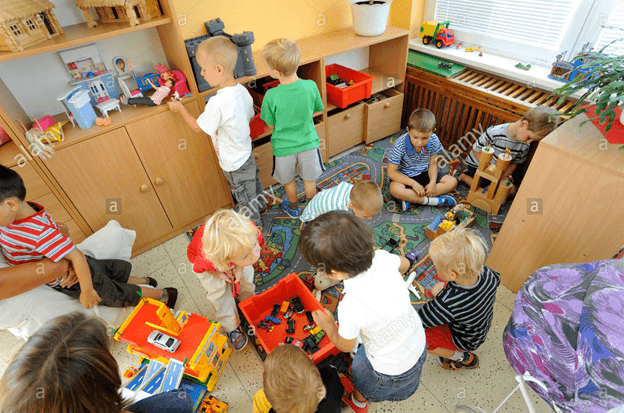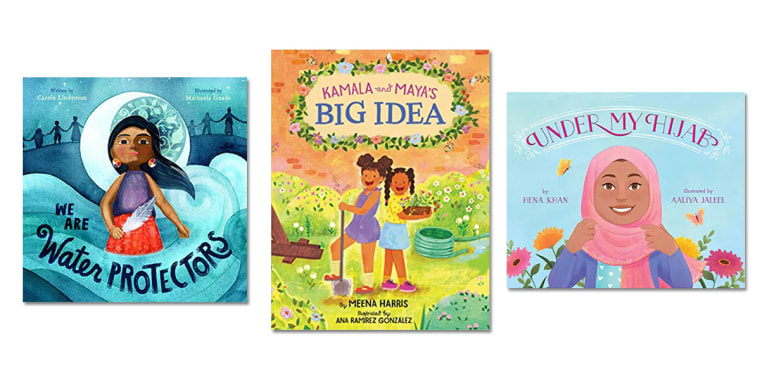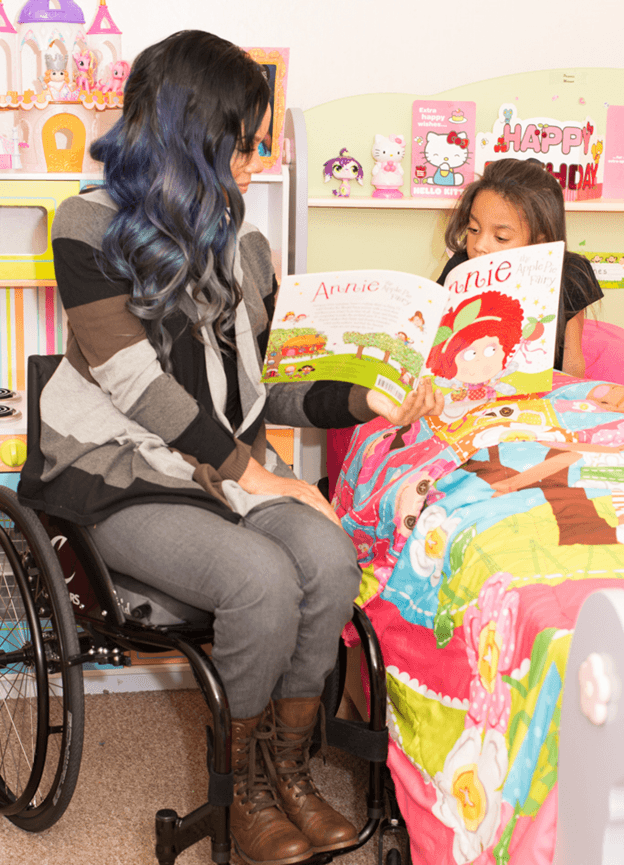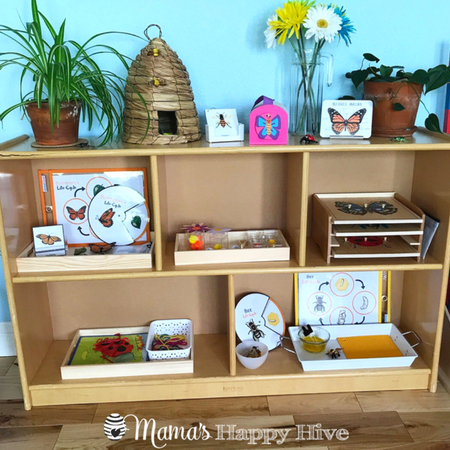3. Room arrangements for play and learning
TRUE or FALSE
One comfortable chair or large pillow is sufficient for the "Cozy Area".
FALSE
"The cozy area is a clearly defined space with a substantial amount of softness where children may lounge and daydream, read or play quietly...One small item, in itself, does not create a cozy area." (p. 18 Notes for Clarification)
Cozy area items: padded chair, beanbag chair, stuffed animals, pillows etc. must be used in combination with each other, not alone.
16. Becoming familiar with print
Please describe three ways teachers can help children become familiar with reading print.
5.1-7.4 Classroom has picture/print materials that relate to current classroom topics and show a variety of words
Staff writes down what children say in an engaging way (dictate what children say about illustrations or block towers, and display the words next to artwork or a photo of the tower.)
Staff points out letters and words as they read out loud
Staff show how print can be useful as a tool (label a toy, reading lunch menu, writing a note to parent etc.)
(any instance where a staff member draws attention to print material would be an acceptable answer)
p. 45
19. Music and movement
How many music materials must be available to children during free play?
5.1 10 instruments in good condition. (p. 51 Music and Movement)
Note: Music player counts as 1 music material. If doing music as a group there must be at least 1 instrument per child participating.
Terms Used Throughout the Scale
Please define what an "Interest Center" is.
"An Interest Center is a clearly defined play area intended for a particular kind of play. Materials are organized by type and stored so that they are accessible... If one or two materials are present that do not match the intent of the centers particular type of play, credit will be given as long as those materials do not interfere with the intent of the interest center." (ECERS-3 p. 11)
7.1 Staff initiate vigorous gross motor activity for part of the gross motor time (Ex: lead interested children in exercises, organize races for children who want to participate, put on music for dancing)
Additional examples can include any gross motor activity initiated by a teacher.
32. Free Play
Please explain what "free play" is.
"Free Play" means that children are permitted to select materials and companions and, as far as possible, to manage play independently. Staff involvement is primarily in response to a childs specific needs, although staff may initiate activities for children to choose if they are not engaged in any activity. (p. 80 Free Play)
8. Meals and snacks
TRUE or FALSE
Staff should not engage in conversations with children during meal times.
FALSE
7.2 "Atmosphere is relaxed with many conversations and pleasant social interaction...staff sit with children and model pleasant interaction"
(p.29)
3. Room arrangement for play and learning
What issues can you see arising from the materials and room arrangement in this photo? How can this classrooms room arrangement be improved?

"Space should be arranged so that classroom pathways generally do not interrupt play" (5.1)
7.3 "Centers requiring more space, blocks, dramatic play, very popular or active play) must have sufficient space to accommodate the type of play required and the number of children who want to participate"
p.19
14. Staff use of books with children
TRUE or FALSE
Reading to your children during circle time in the morning is enough to meet the requirement for staff use of books with children.
FALSE
7.3 "Staff should use books, informally, with children on more than one occasion" (p. 41 Staff use of books with children")
Examples:
Pointing out pictures in books
informally telling the story of a book
Listening to a child tell the books story
Using an encyclopedia/non-fiction book to answer a question
Discussing the books details
Felt board story reenactment
18. Art
There must be ONE art material available from each category: Drawing, Paints, 3-D, Collage,Tools.
Please give TWO examples of 3-D art materials.
Boxes
Clay
Modeling Compound
Pipe Cleaners
Play dough
Wood Scraps
"Junk" (i.e. cardboard, tubes, packing material, etc.)
p. 48-49
18. Art
TRUE or FALSE
For an excellent rating, almost all of the observed evidence of art activities should indicate that the children did an art activity that a teacher planned and provided specific materials for.
FALSE
5.2 "Most art activities should allow children to use materials in their own way" (p. 49)
"In lesson plans, there should be evidence of no more than two examples of teacher-directed projects where children follow an example" (p. 48)
31. Peer interaction
TRUE or FALSE
When there is conflict between children, staff should only intervene once children start fighting or crying.
FALSE
7.2 "Staff should help children avoid conflicts (i.e. notice when a problem is brewing and provide closer supervision. Have a system to ensure fair turn taking, such as a waiting list, provide enough popular choices during free play)...
Staff should point out positive social behavior between children such as praising children who help others, work together, or sharing without fighting. Children should be given plenty of time to select companions, who to sit with at lunch, and have activities set up for successful cooperative play."
(p.75, Peer Interactions)
33. Transitions and waiting times
"The schedule must be organized so there are no long periods of waiting between daily events."
How much time is considered "A long period of waiting"?
7.2 A long period of waiting means children are without any activity for 3 minutes or more. (p. 79 Transitions and waiting times)
This is most likely to happen during hand washing, group restroom breaks, before and after lunch.
10. Health practices
How far apart should cots be, ideally?
"An attempt must be made to place all cots/mats atleast 36 inches apart. If children are less than 36 inches apart they should be alternated head to foot to avoid breathing in each others airspace. (p. 33)
3. Room arrangement for play and learning
At minimum, how many interest centers should be available to children?
5.2 Atleast 5 interest areas are used, including a cozy area protected from active play" (p. 19 Room arrangement and learning)
12. Helping children expand vocabulary
When doing activities to expand childrens vocabulary, how could you provide special accommodations for children who have disabilities and/or children with different family languages?
Please provide one example.
5.4 Demonstrate the meaning of words with body or hands
Use sign language with speech
Use a language board
Use pictures and visuals of everyday objects and routines
Use technology
23. Math materials and activities
"Math in Daily Events" is described as a way math concepts are integrated, organically, in regular exchanges with children through daily events (i.e. talking about shapes of traffic signs on a walk, counting to 20 while washing hands etc.)
"Math Activities" are teacher initiated and directed and go beyond children's use of materials in free play with teacher input.
Please give an example of a "Math Activity"
Any example given with a planned activity that includes counting/comparing quantities, measuring/fractions or familiarity with shapes will suffice:
Examples:
Sorting shells by size or shape
Reading a thermometer to chart daily temperature
Using measuring cups during a cooking activity
Playing card games, dominoes, dice etc.
Using an abacus
Making bead patterns
(p. 58 Math materials and activities)
20. Blocks
TRUE or FALSE
Blocks must be organized by shape/size and type with labels on the shelves that show images or outlines of the blocks to be stored there.
TRUE
Example:

p. 53
32. Discipline
Please give one example of inappropriate discipline or "rigid control".
Inappropriate discipline:
Withholding food or physical activity
Shouting or yelling
Mocking, using negative talk (ex:"He is being lazy")
Shaming due to bathroom accidents
Yanking, rough handling
Using fear or scare tactics
Developmentally inappropriate expectations and rigid control such as:
Forcing sharing, cooperating, confining a child for long periods, requiring long periods of silence or sitting still, long periods of waiting
Requiring minimal talking from children
(p. 77, Discipline)
35. Whole-group activities for play and learning
TRUE or FALSE
Group Activities such as circle time must include ALL children.
FALSE
7.2 "Group activities are usually carried out in smaller groups rather than in one large group (Ex: younger children, or others with trouble participating, are placed in smaller groups" (p. 83 Group Play Activities)
Children should be strongly encouraged to engage in circle time/whole group activities, but not forced. Children who are unwilling to participate may be given an alternate activity.
11.Safety Practices
TRUE or FALSE
You can provide a stimulating environment for children that is 100% risk free.
FALSE
"No stimulating environment can be completely safe for young children. Therefore, the intent of this item, and others where safety is a consideration, is to lower the risk of injury to children by minimizing hazards and providing appropriate supervision for the age and ability of children in the group."
p.34
4. Space for Privacy
An indoor space for privacy should be physically available in the classroom or outdoors where 1-2 children can play without intrusion away from the group.
Please give one example of a private space.
Examples:
Art easel for 1-2 children only
Writing table with 1-2 chairs
Small sensory bin big enough for one child
Reading nook with 1-2 chairs
(Any space where it is indicated either verbally or visually that only 1-2 children are allowed in that space at a time is a correct answer)
p.21
15. Encouraging children's use of books
Please give two examples on how this book shelf could be improved to encourage children to use books

-Less crowding (put some books into storage and rotate frequently
-Organize by type/topic so children can easily find what they are interested in
-Display books so covers can easily be seen to entice children to explore further
p.43
20. Blocks
How many accessories should be present in the block center for an excellent rating?
**Bonus: receive an extra 300 points if you can name all accessory types**
5.1 enough space, unit blocks and accessories from 3 categories accessible for 3 children to build sizeable independent structures at the same time (p. 53)
Accessory types:
1. Small people
2.vehicles
3. Animals
4. Signs, fences, trees, small buildings
(p. 52 Notes for clarification)
TRUE or FALSE
Your dramatic play center only needs basic materials like dolls and play food.
FALSE
"Children should have additional props to use either additional housekeeping toys or materials from other themes such as:
Different kinds of work (equipment and clothing from different jobs/careers)
Fantasy (make believe)
Leisure (camping, sports, travel)
Dramatic play materials should change periodically based off the interests of the children. (p. 54 Dramatic play)
Examples:

30. Staff-child interaction
What are children's nonverbal cues and how can staff respond to them appropriately?
Book examples:
Recognize when children need physical activity and take measures to provide it
Recognize signs of boredom or lack of engagement and switch to something more interesting
(Any example in which a staff member responds to a child's non-verbal cue would suffice)
33. Transitions and waiting times
What are TWO strategies teachers can have in place to avoid chaotic transitions?
-Transitions are gradual or individualized (ex: children can go outside while others are still getting ready, children can join circle time once finished eating)
-Staff give ample warnings that clean up time/next transition is coming
-Staff are well prepared for next activity by coordinating roles [with co teachers] to ensure more difficult cleanup tasks are supervised more closely to avoid delays
-Activities that expand learning: use songs/music to initiate transitions, have a system for lining up and clear expectations for children (ex: visual aids on floor/wall)
p.79
9. Toileting/diapering
What are TWO examples of how staff can teach children to ensure they carry out proper toileting/diapering procedures correctly?
-Visual steps for handwashing posted for children's reference
-Using songs to help children know how long to wash (Handwashing song, happy birthday etc.)
-Staff model correct handwashing procedures(p. 31)
5. Child-related display
How much of the display materials should be the children's individualized artwork?
"About one-third of the display materials should be children's individualized artwork" (p. 23 Child related display)
The rest of the displays should include:
Permanent displays (clock, calendar, classroom jobs, weather wheel etc.)
Displays related to the current interests of the children in the group (i.e. photos of children doing projects and photos relating to the current unit or theme).
15. Encouraging childrens use of books
How many books on display should relate to your classrooms current theme or unit?
7.2"At least 5 books that relate to current classroom activities or themes are accessible and easily observed" (p. 43 Encouraging childrens use of books)
Example: Gardening Theme

26. Promoting acceptance of diversity
At least 4 types of diversity(race, culture, age, ability and non-traditional gender role) must be present, with a total 10 easily visible examples.
These examples should be found in which THREE places:
5.2 At least 1 example from each:
Books

Displays (photos/posters)

Play Materials (Dolls, dramatic play area, puppets, music etc.)

(p. 65 Promoting acceptance of diversity)
Terms Used Throughout the Scales
Would this area be considered an "Interest Center" or a "Play Area?". Why? How could it be improved?

This area would be considered a "Play Area" because there is no clearly defined purpose of the materials.
"The shelves holding the toys and materials should not be crowded" (p. 17 Furnishings for care, play and learning)
"Accessible books should be displayed in order to encourage book use (Ex: books not crowded on shelf, many covers easily seen" (p. 43 Encouraging use of books)
"Quiet and noisy play areas are all separated from one another, not just by furniture but by physical space" (p. 19 Room Arrangement and Learning)
29. Individualized teaching and learning
Please explain what "open-ended" materials and activities are.
1.2,3.2,5.1
"Open-ended" materials/activities are those in which children can use materials appropriately in their own way, with an outcome that is not predetermined by the staff or the material itself. (p. 70, Notes for Clarification)
34. Free Play
For a high rating, a clear system should be used to permit satisfying participation in activities. What are some examples of these kinds of systems that can be used?
5.4
Timer used to limit turns to a reasonable time so that activity can be completed
Waiting list can be used to ensure all interested children get a turn
Visual aids: Photos of center or activities and children's photos on clothespins to help children visually see options and choose based on interests
Having duplicates of materials on hand
8. Meals and Snacks
TRUE or FALSE
Handwashing procedures must be followed with no mistakes or lapses from children in order to meet the indicator.
FALSE
"There can be minor lapses in following the handwashing procedure. (ex: not rubbing for 20 seconds, but rubbing all hand surfaces, not wetting hands first but soap still makes bubbles) However hands must be cleaned reasonably well and a significant attempt to complete all practices was made. (p. 28 Meals/snacks)
7. Gross motor equipment
How many skills must the gross motor equipment offer children? (indoor and outdoor)
***BONUS***
Please give two examples of a gross motor skill. (100 points for each skill listed)
3.3 Minimum requirement: Equipment must stimulate at least 7 different skills" (p. 27 Gross motor equipment)
Skills: Pulling, pushing, hanging by arms, swinging, jumping, hopping, tossing things into container, catching, throwing or kicking.
Skills that are not stimulated by equipment, such as running, hopping or skipping is not counted.
12. Helping children expand vocabulary
A child in a classroom tells their teacher "I saw a truck outside!" The teacher responds "I like trucks".
What else could the teacher have said to help this child expand his understanding?
7.3 Staff add information and ideas" Expand Children's Understanding- meaning that staff respond verbally to what a child has said and carry the childs idea further, providing additional information and vocabulary that the child can attach to the meaning of what he or she said.
Examples:
"That is a dump truck, the back part carries heavy loads like dirt or rocks and it tips up to dump the dirt out!"
"That is a garbage truck, it picks up our trash for us and uses a big compacter to squish the trash like this..."
"Trucks come in many sizes. Some trucks are really big and can carry lots of things behind them. Truck drivers have beds behind their seat so they can sleep when they are not driving."
Any example that would expand a childs understanding of the topic would be correct
(p. 37, Helping children expand vocabulary)
17. Fine Motor
There are four types of fine motor materials. Children must have access to one of each type.
What are the four types of fine motor materials?
1. Interlocking building materials (interlocking bristles, logs, legos etc.)
2. Art materials (crayons, scissors, paint brushes)
3. Manipulative (stringing beads, pegs, pegboards etc.)
4. Puzzles (floor puzzles, framed puzzles etc.)
p. 46-47 Fine motor/Notes for clarification
22. Nature/science
Your Nature/Science center must contain 15 materials total, with at least ONE material from each of the 5 listed categories.
What are the 5 Nature/Science categories?
At least one material from each (15 total):
1. Living things (plants, pets, garden)
2. Natural objects (leaves, insects, rocks, shells, seeds)
3. Non-fiction Science books/ Pictures
4. Tools (Magnifying glasses, magnets)
Sand or Water (with measuring cups, digging tools and containers)
Example:

29. Individualized teaching and learning
Please explain the difference between "One-size-fits-all" teaching approach and "Individualized teaching" approach.
"One-size-fits-all means that staff teach children using the same methods and content for all children, with no attention paid to individual needs related to age, ability, interests or learning style...
Individualized teaching is when a teacher can determine when children are experiencing failure and judge whether children can understand the content of activities. When successful, children are interested, complete tasks within a reasonable amount of time and are not forced to complete tasks that are too difficult."
Individualized teaching can occur during free play. Staff circulate to various areas of room; children's play is enhanced and not interrupted when teaching occurs.
Example: counts blocks with child who built a tower, shows child how to play sorting game, has conversation with child involved in dramatic play.
(p. 71, Individualized teaching and learning)
34. Free Play
Lets imagine your current classroom theme/topic of interest is "Farming". What are some materials or activities you could have accessible during free play that relate back to your theme and can help expand children's knowledge?Any idea relative to "farming" that children would find engaging is a correct answer
Examples:
Sensory table with dirt, small, farm animals, seeds, small tractors etc.
Add a farm stand to your dramatic play center to sell fruits, vegetables, eggs and milk etc.
Add photos of the life cycle of a chicken egg to your nature/science center, books about eggs hatching, dried ears of corn for exploration etc.
Technology: Show children a video of a dairy farm
10. Health Practices
What are the 5 times when handwashing is required?
(1) Upon arrival into the classroom, re-entering the classroom after being outside
(2) Before and after the shared use of wet materials (ex: play dough or water
(3) After play with shared sensory materials such as sand, rice or messy play
(4) After dealing with bodily fluids
(5) After touching contaminated objects and surfaces such as trash can lids, and animals